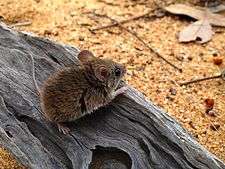Pilliga mouse
| Pilliga mouse | |
|---|---|
 | |
| Scientific classification | |
| Kingdom: | Animalia |
| Phylum: | Chordata |
| Class: | Mammalia |
| Order: | Rodentia |
| Family: | Muridae |
| Genus: | Pseudomys |
| Species: | P. pilligaensis |
| Binomial name | |
| Pseudomys pilligaensis Fox & Briscoe, 1980 | |
Pseudomys pilligaensis, commonly known as the Pilliga mouse or poolkoo, is a species of rodent in the family Muridae. Until recently its distribution was said to be restricted to the Pilliga forest region of New South Wales, Australia but in 2013, a specimen was trapped in the Warrumbungle National Park after a bushfire. There are also suggestions that it is a hybrid between two other species. Its conservation status is currently listed as "Data Deficient".
Description
P. pilligaensis is a small brown mouse with grey-brown upper parts, the head and back greyer, grading through russet flanks to white underparts. The feet are pale pink on top with white hairs. The head-body length is 73–80 millimetres (3–3 in) and the tail about the same length or slightly less. The tail is pale pink with a distinct brown line along the top and a small tuft of darker hairs on the end. The ear length is 15–18 millimetres (0.6–0.7 in) and the weight of the animal is 10–14 grams (0.4–0.5 oz).[1][2]

Taxonomy
The Pilliga mouse was first formally described in 1980 by Barry Fox and David Briscoe. They distinguished it from the similar species P. novohollandiae, P. delicatulus and P. hermannsburgensis on the basis of characters such as skull size and shape and the ratio between tail and head/body length.[3] More recent work has suggested that it is a southern population of the delicate mouse Pseudomys delicatulus.[4][5] Another suggestion is that it is it a hybrid between Pseudomys delicatulus and the New Holland mouse (Pseudomys novaehollandiae).[6]
Distribution and habitat
P. pilligaensis was described as having a restricted distribution in the Pilliga forest in central New South Wales, having been collected from only four sites within the Pilliga "scrub", none more than 50 km apart. Two of the capture site were in Cypress–Eucalypt forest and the others in woodland.[3] However, after a bushfire in January 2013 which burned about 80% of the Warrumbungle National Park, a specimen was collected in that park. Pilliga mouse populations increase rapidly in size after fire and it is possible that this may occur in the new area.[6] Recent research indicates that population density is highest in recently burned areas with broombush (Melaleuca species), kurricabah (Acacia burrowii) and bloodwood (Corymbia trachyphloia) where the ground is covered with post-fire grasses, sedges and ash from bushfire. The mouse is nocturnal and apparently lives in burrows.[6]
Conservation
As of January 2015, the Pilliga mouse is currently listed by the IUCN as "Data Deficient" because of the uncertainty of its taxonomic status. If further research indicated that the Pilliga mouse is a separate species, its status would be determined as "Endangered".[7] Threats to the population in the Pilliga include exploration and infrastructure construction relating to coal seam gas, as well as habitat loss through forestry, predation by the introduced cat and fox, and competition from the house mouse.[1]
References
- 1 2 "Pseudomys pilligaensis". Australian Government Department of the Environment. Retrieved 2 June 2015.
- ↑ Menkhorst, Peter; Knight, Frank (2001). A field guide to the mammals of Australia. South Melbourne, Australia: Oxford University Press. pp. 194–195. ISBN 019550870X.
- 1 2 Fox, Barry; Briscoe, David (May 1980). "Pseudomys pilligaensis: A new species of murid rodent from the Pilliga scrub, northern New South Wales". Australian Mammalogy. 3: 109–126.
- ↑ Dyck, Steve Van (ed.); Strahan, Ronald (2008). The mammals of Australia (3rd ed.). Sydney: Reed New Holland. p. 880. ISBN 9781877069253.
- ↑ Woinarski, John C.Z.; Burbidge, Andrew A.; Harrison, Peter (2014). The action plan for Australian mammals 2012. CSIRO. ISBN 9780643108738.
- 1 2 3 "Piliga Mouse - profile". N.S.W. Government Office of Environment and Heritage. Retrieved 2 June 2015.
- ↑ "Pseudomys pilligaensis". The IUCN Red List of Threatened Species 2015.1. Retrieved 2 June 2015.
